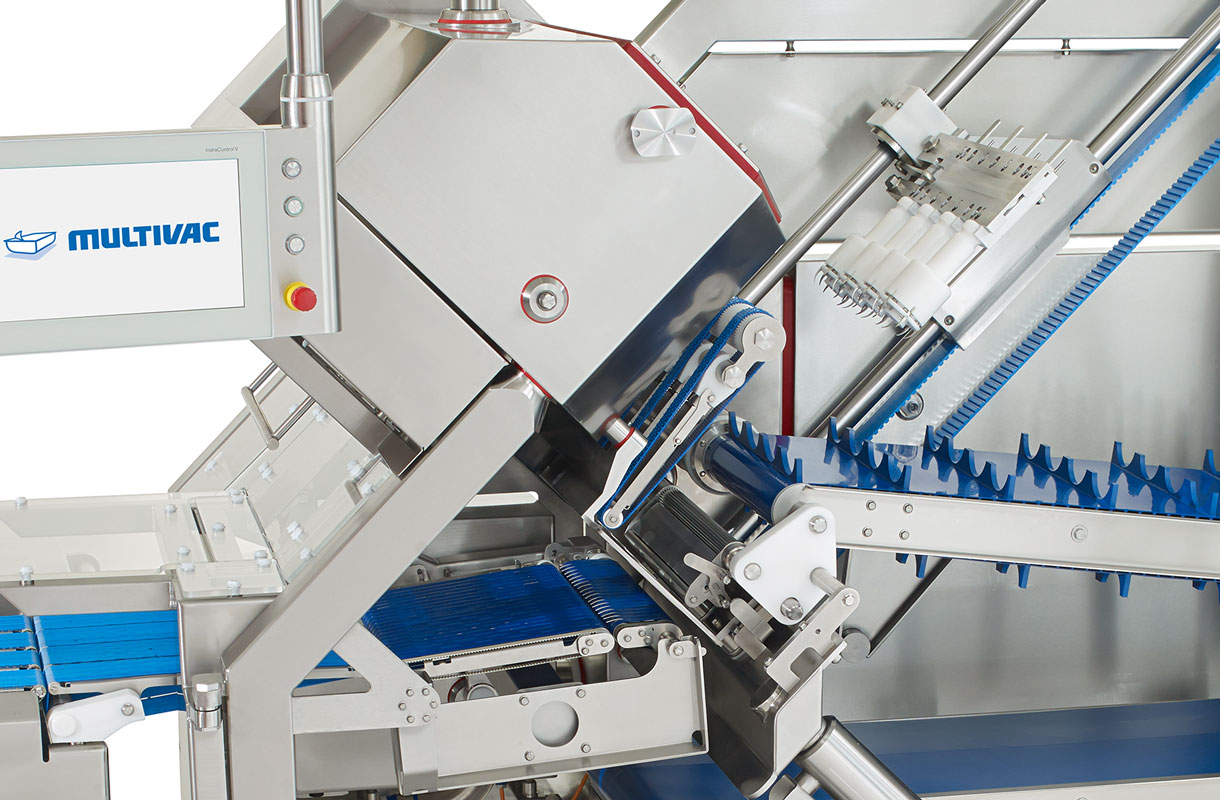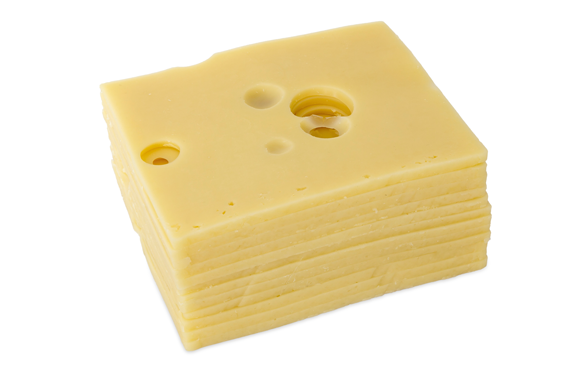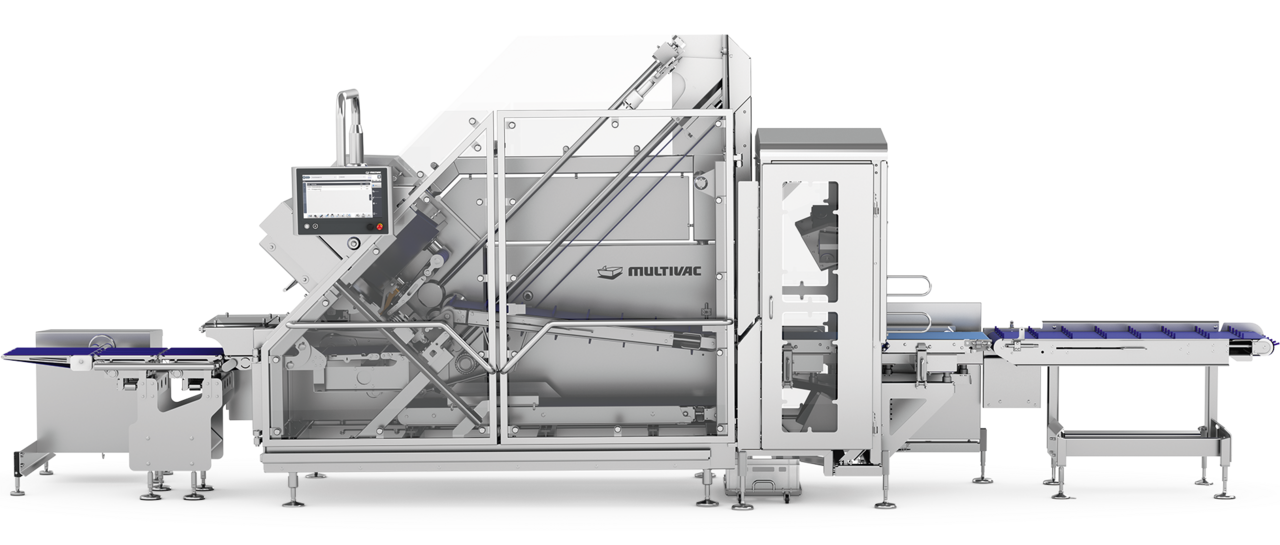


Cheese enjoys great popularity with consumers. In 2018 the consumption per head in Germany was some 24.2 kilos. In the European ranking Germany holds third place behind France and Finland. The proportion of cream cheese, hard and semi-hard sliced cheese totaled around two thirds of the overall amount.
When slicing and packing sliced cheese, the process has to be designed to the optimum degree for the particular product. Semi-hard sliced cheese does not mature for as long as hard cheese - it has a lower dry matter and is therefore softer. The maturation time is generally four to six weeks, and the water content in the fat-free cheese mass is between 54 and 63 percent.
When slicing cheese, the crucial factors in addition to the performance and slicing quality of the slicer are a high yield, weight accuracy and reduction in give-away. Given the current trend towards ever greater variety of cheese types in ever smaller batch sizes, there is also a requirement for maximum flexibility. The slicer must therefore be able to handle a wide range of products in different formats and consistencies, as well as with and without rind or even with holes. The necessary format and product changes also need to be carried out as rapidly and easily as possible. If the slicing process stage is an integral part of a complete line, the downstream packaging process must also be included in the overall concept, so that the maximum efficiency and best possible packaging result can be achieved. A precise and attractive placement of the slices in the pack is particularly important for the optimum presentation of the sliced product at the point of sale.

The core elements of a slicer include the loading unit, the slicing system, and the product guide. The slicing quality is determined primarily by the slicing technology used, and in particular the flexible adjustment of the blade speed to the particular product. The geometry and characteristics of the slicing blade are the defining elements of the slicing technology.
Fully automatic central loading ensures that product change times are very short, which gives a high level of efficiency in the slicing process. The consistent position when loading enables the products to be aligned precisely during slicing irrespective of tolerances, and this results in accurate and uniform loading of the slices into the packaging machine. Servo-driven product guidance units above and below the cheese block allow it to be fed continuously and gently to the slicing blade without any pressure. It is essential for optimum slicing quality and accuracy, and therefore for the yield as well, that the product is fed to the blade without any pressure.
MULTIVAC currently offers two slicer models, the S 800 and S 1600, which provide the highest possible slicing quality and are extremely impressive, particularly in regard to their groundbreaking blade design. Even in the case of round products, MULTIVAC slicers ensure that, irrespective of the cheese block tolerances, the product is guided consistently in the middle of the track. Thanks to the special blade design, there is the optimum ratio between pressure and traction at every point of contact, and this ensures the cheese is sliced very gently and precisely. This “soft cut” allows the special blades to slice smoothly through the product in a controlled way and without any pressure.
Both slicers are very flexible in the type of portion they can produce - the spectrum ranges from precise placement of slices in shingled portions and straight or staggered stacks, through to the shingling of wafer-thin cut product, and right up to the folding of individual slices. The servo-driven portioning system, which can be lowered, enables stacked portions to be produced in all the standard heights.
Whereas the correct tempering of the product is very important when slicing sausage or meat, it is possible to slice cheese gently and precisely within a larger temperature range. Thanks to the groundbreaking slicing technology of the MULTIVAC slicers, the product can be processed with just moderate chilling or even at room temperature depending on its consistency. This also has a positive effect on energy usage. This enables the storage time between manufacturing and slicing to be reduced, and less chilling capacity is required for the product in the production and slicing areas. And last but not least, MULTIVAC slicers are equipped with energy-efficient servo drives, which means that the costly resource of compressed air can be saved.
One of the most important factors in achieving the optimum slicing result is an even forming of the cheese block, which can range from soft cheese to semi-hard cheese and hard cheese. Even forming gives a consistently formed cross section over the entire product length. This enables evenly sized and evenly thick slices to be cut over the entire block. Trim with the first cut should generally tend towards zero. In a few cases however, it is necessary to have some trim from the first cut due to quality requirements. The size of the first cut trim can be set on MULTIVAC slicers by means of the product start sensor, and this means it can be kept as small as possible.
When producing fixed-weight packs, it is necessary to have the highest possible weight accuracy, since there is subsequently no possibility of having any effect on the weight of the pack. The more accurately the weight of the individual slices can be maintained, the closer the target weight of the pack comes to the stated nominal weight, so that the individual packs do not fall below the minimum quantity demanded by legislation on finished pack weights. The proper design of the forming set tooling plays the most important role here.
Since cheese is however a natural product, which is not always available in ideally formed blocks, additional measuring systems can be used to determine the distribution of the product volume prior to the start of slicing, so that the necessary slice thickness for achieving the target weight can be calculated. MULTIVAC therefore equips its slicing solutions with product volume measuring systems, which can be used for products with a length of up to 600 mm or 1200 mm. These are multi-track measuring systems with laser scanners, which deliver measured results irrespective of the tracks. This enables even naturally formed products to be portioned with precise weights, while the give-away is also minimised.
In addition to precise product measurement on the slicer, the weight accuracy can be further increased with other systems for product monitoring and subsequent weight adjustment. With MULTIVAC slicers in a multi-track line layout, it is possible to connect 2, 3 or 4 combined weighers in series, so that precise throughput monitoring can be achieved without the time-consuming conversion of the combined weigher at every product change.


A high degree of flexibility in the slicing process is required, if processors have to produce a very diverse range of products. MULTIVAC offers its customers a simple and rapid format change, which is designed to be as user-friendly as possible while also providing maximum process reliability - and this is reflected in the minimal set-up times and high level of machine availability.
In the case of both the S 800 and S 1600 slicer models, the cutting frames and belts can, for example, be changed very quickly with just a few hand movements and without any additional tools. Quick-change systems for the grippers significantly accelerate and facilitate conversion to different products and block sizes, since the grippers no longer require time-consuming adjustment after conversion. The whole process is completed in just a few minutes. In contrast to other systems in the market, it is not necessary to release or refit any pneumatic connections, when fastening the specifically designed product grippers.
Some of the most important features of the MULTIVAC slicing solutions are the simple machine control via a clear and intuitively operated display, as well as quick and reliable cleaning of the individual modules.
The geometry of the MULTIVAC blades also contributes to an extended service life thanks to their longer cutting edge. The lifespan of the blades is also extended significantly by the wide regrinding range up to the two-digit mm extent. Both factors have a significant effect on the efficiency of the slicing process. The load cells on the checkweighers are also designed for durability. They are designed with an extremely robust stainless steel construction and certified to IP69K.
It is however not only the slicer, which is crucial for the efficient slicing of cheese with the highest level of slicing quality and at the maximum output and yield. Weight accuracy and minimal give-away can also be optimised by means of precise product measurement and the use of additional checkweighers. And last but not least, an integral part of a high-performance production line is the efficient linking of the slicer to the packaging machine. In addition to its comprehensive range of machinery and ancillary equipment, MULTIVAC also has outstanding expertise in turnkey projects and complete lines. Customers benefit enormously from integrated solutions from one source, where the main features are the smallest possible footprint, perfectly synchronised process stages and optimum line control via one intuitive operating concept with maximum process reliability.
The portions produced by the slicer are transported to the automatic packaging machine by means of belt systems, such as the MULTIVAC Belt Loader. The modular system can be individually adapted to the particular requirements. It gently transports the portions and loads them precisely into the packs and, thanks to its buffering function, ensures a constant product flow is maintained. The high output, simple cleaning, and easy operation of the MULTIVAC Belt Loader also contribute significantly to the efficiency of integrated slicer lines.
The MULTIVAC Horizontal Loader, which performs extremely gentle and efficient loading of the products, is also available for transferring a wide range of sliced portions efficiently from the slicer into the thermoformed pack cavities. The loading conveyor from the slicer is placed at the same height as the loading area of the thermoform packaging machine, and this means that no height differences between the slicer and the packaging machine have to be overcome, allowing the length of the line to be reduced significantly. Thanks to the quick and easy conversion of the MULTIVAC Horizontal Loader, it is possible to pack a wide range of products without any loss of efficiency.
If a wide range of pack types or a high level of flexibility in pack shapes and dimensions is required, it is possible to use robot solutions for loading the products. Thanks to their speed, flexibility, and precision, robots make a major contribution to higher levels of efficiency, quality, and improved hygiene in the packaging process. The features of MULTIVAC's handling modules are maximum flexibility and the particularly efficient and gentle loading of all sliced products. They can be used very flexibly for a wide variety of products, pack formats, and cycle times. As the most simple form of presentation, individual portions can be packed in one or more stacks. However, it is also possible to create more complex loading patterns – even wafer-thin cheese slices can be shingled in multiple staggered or overlapping rows, or arranged in a round or oval shape.

05.12.2019